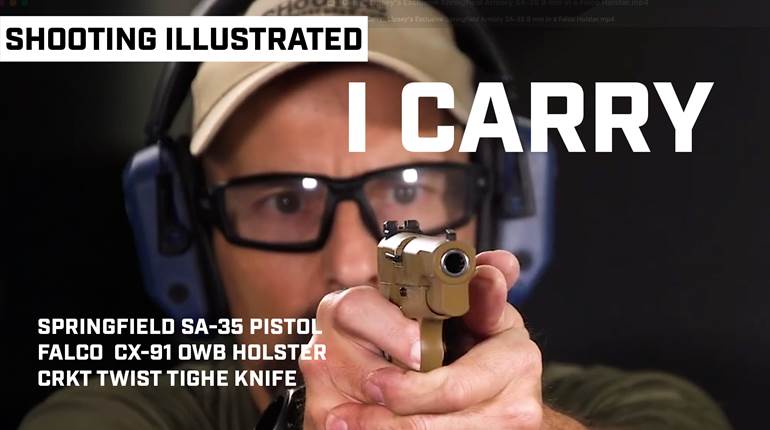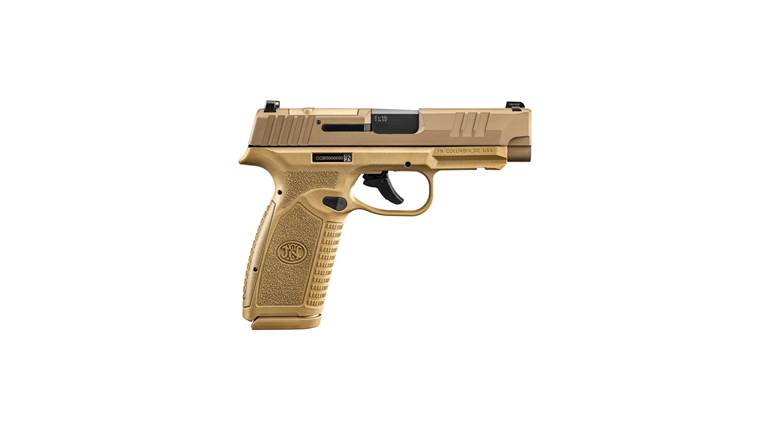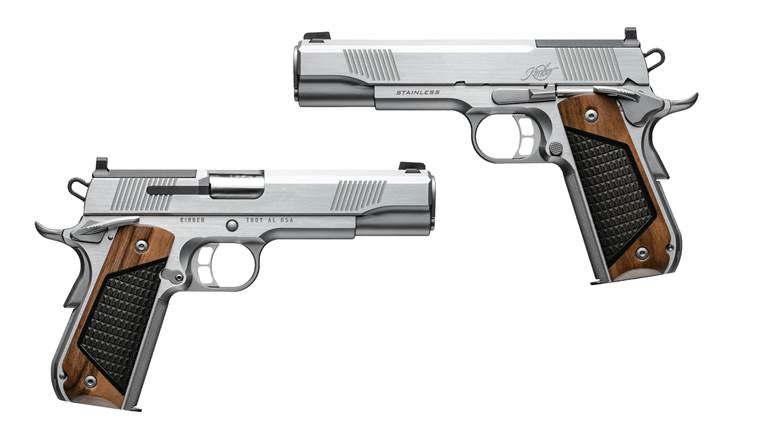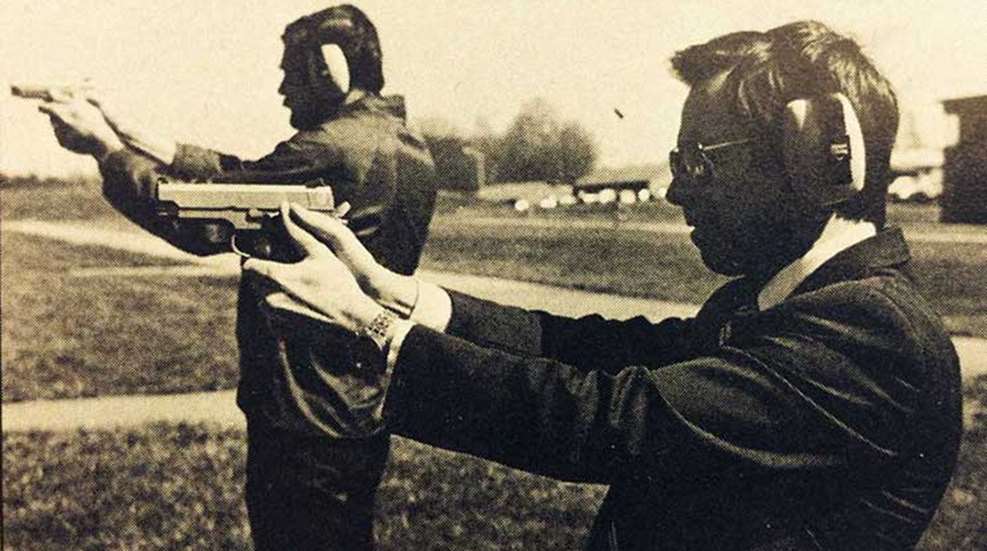
First published in American Rifleman, June, 1990
By Charles E. Petty
The tragic gunfight that saw seven FBI agents killed or wounded in Miami, Fla., on April 11, 1986, has been well documented, analyzed and studied, but the real repercussions are only now being felt. The impact comes in the form of a far-reaching study of law enforcement ammunition that, in tum, has led to the adoption by the FBI of a new pistol chambered for the 10 mm Auto cartridge. 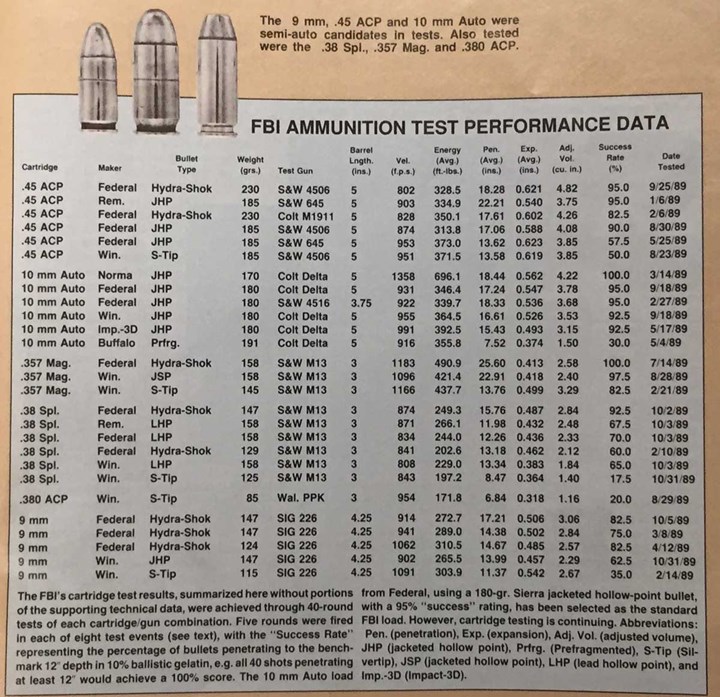
Very early in the Miami gun battle, FBI Agent Jerry Dove fired a bullet that stopped about 2" short of cop-killer Michael Platt's heart. Platt fought on; Agent Dove was among those killed in the ensuing battle.
“All other things aside, Miami was an ammunition failure,” said John Hall, chief of FBI's Firearms Training Unit (FTU). It is vital to know that Dove's shot happened before any federal agents were seriously wounded. The tragedy that ended with two agents murdered, five wounded and both assailants dead has led to a wound ballistics workshop and ammunition study that will dramatically alter the way we think about handgun ammunition.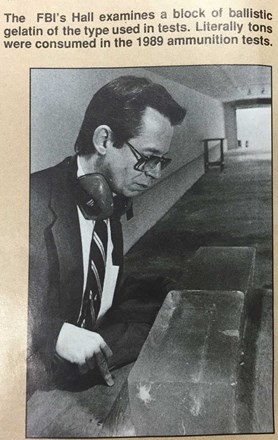
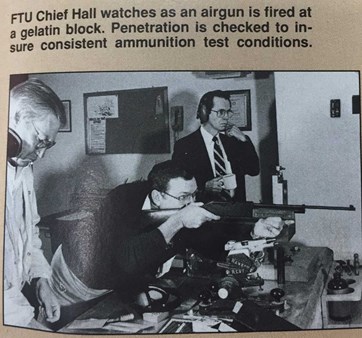 The job of a handgun bullet fired in self-defense is to incapacitate the assailant. Writing in the FBI Law Enforcement Bulletin for November 1989, Hall said: “Incapacitation in the law enforcement context, may be simply described as bringing about the immediate cessation of hostile or threatening activities.”
The job of a handgun bullet fired in self-defense is to incapacitate the assailant. Writing in the FBI Law Enforcement Bulletin for November 1989, Hall said: “Incapacitation in the law enforcement context, may be simply described as bringing about the immediate cessation of hostile or threatening activities.”
The key word here is “immediate.” During the wound ballistics workshop, attendees learned that there are only two ways by which a handgun bullet can produce rapid incapacitation: disruption of the central nervous system or production of massive blood loss that, in turn, causes unconsciousness. And the only way a handgun bullet can do that is to directly penetrate major blood-bearing organs or vessels. The purpose of the workshop was to debate the relative merit of the 9 mm vs. the .45, and the participants came mainly from the field of forensic medicine. Doctors who work in big city morgues get to see lots of gunshot wounds, and it was their expertise that had been notably absent from previous studies.
One of the participants, Col. Martin Fackler, MD, head of the U.S Army Wound Ballistics Laboratory, addressed the National Institute of Justice's Relative Incapacitation Index (RII) studies (see January 1985, p. 44, and October 1975, p. 38).
“These studies,” Fackler said, “ranked bullets solely according to the temporary cavity produced in ordnance gelatin. They assumed that incapacitation of the human target by a given bullet is directly proportional to temporary cavity size. No physiologic mechanism was even postulated for this supposed effect—much less proved. Temporary cavity size for a given bullet can be increased very simply by decreasing bullet weight and increasing velocity." But human tissues are quite elastic and suffer little or no permanent damage or bleeding from the temporary cavity formed by a bullet, Dr. Fackler holds. The only way a bullet can produce a significant effect is to directly penetrate the tissue.
Dr. Fackler concluded: “The critical consideration is that the bullet produce its permanent tissue disruption to sufficient depths to insure major vessel disruption from any angle.”
The FBI ammunition study has prompted cries of “foul” from those who feel it indicts their cherished 9 mm and huzzahs from fans of the .45 ACP. In fact neither of those responses is warranted or fully supported by the facts of the study. What is there is the basic information upon which someone can make an informed decision about ammunition or caliber whether he is a law enforcement officer or an armed citizen.
“The best you can do is increase the probability of incapacitation,” Hall said. And that was the real goal of the study—to learn what rounds had the highest probability of success under the conditions determined appropriate for the FBI's needs.
“We did not set out to find the ideal police bullet; we set out to find the best round for the FBI. Credible information based on valid research was hard to find,” Hall said.
Urey Patrick, assistant chief of the FBI's FTU, was more direct and certainly more provocative. He said, “There was no meaningful ammunition testing prior to 1988.”
Analysis of actual shooting incidents revealed an alarming fact. Assailants who received wounds that were ultimately lethal were still able to continue hostile activities for periods of up to several minutes. Since it is unrealistic to designate the central nervous system as a primary target, bullets used by law enforcement officers must be capable of penetrating far enough to insure that they can strike important organs or blood vessels. 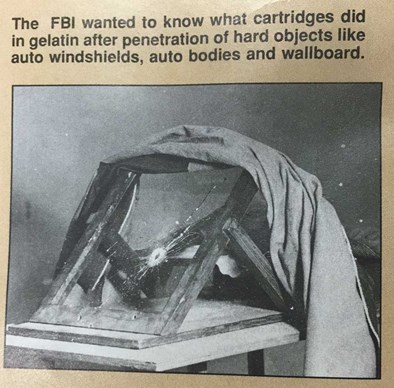
Based upon anatomical averages, the minimum penetration considered acceptable was 12". On this point there was consensus among the workshop participants. This fact alone casts serious doubts upon the bullets designed by RII criteria which held that penetration of 6" to 8" was enough.
Another favorite topic—overpenetration—was also discussed.
Hall said: “Considering that approximately 80% of the rounds fired by law enforcement officers engaged in violent encounters do not strike the intended targets, it was deemed somewhat unrealistic to attach too much significance to the potential risks of over-penetration on the part of those that do.”
Or, as Dr. Fackler put it, again more directly, “No law enforcement officer has been killed because of a bullet that overpenetrated, but underpenetration gets cops killed.”
The 12" minimum penetration standard was derived from studying human anatomy. Vital structures usually lie deep within the body and are well protected by both bone and muscle. Real shooting situations rarely find the combatants facing one another. Instead, shots are frequently fired from oblique angles that increase the need for penetration.
Development of the eight separate test events was begun by a careful review of actual shootings in FBI files. Most prior testing had involved shooting into bare ballistic gelatin to estimate bullet performance, but that is an unrealistic condition.
“We don't shoot naked people very often,” Patrick said. So seven of the eight events used varying levels of clothing over gelatin blocks more realistically to challenge the bullet. One test event did use bare gelatin to provide a reference point with other, historical, observations.
Approximately 50% of the recent incidents involved criminal suspects in automobiles, so three of the test events used automotive materials.
The final test design included eight separate events that effectively simulated most shooting situations. The test medium was 10% ballistic gelatin, and a new block was used for each shot. The consistency of each gelatin block was verified by a simple test: a match grade BB was fired from a pump BB gun. If the gelatin was properly prepared, 10 strokes of the pump resulted in 3 ½ -4" of penetration. If this standard was not met, the block was discarded.
Five shots were fired in each of the test settings. Where obstacles were included, the gelatin block was placed 18" behind the obstacle and covered with material representing light clothing. Guns were fired from a Ransom Rest. All materials were standardized as to thread count, etc.
Whenever possible, the test firearm was a model approved or issued by the FBI. In order to avoid “rater bias,” all measurements were made by agents from the FBI's Institutional Research and Development Unit “in the blind” (they did not know which rounds they were measuring) to insure statistical validity.
The test events were:
Test 1: Bare gelatin at 10 ft.
Test 2: Heavy clothing at 10 ft. (T-shirt, flannel shirt, 10 oz. down, cotton denim)
Test 3: Automotive sheet metal at 10 ft. (two pieces of 20-ga. hot-rolled steel spaced 3" apart). This simulates the thinnest portion of an automobile door.
Test 4: Wallboard at 10 ft. Two pieces of standard 1/2" gypsum wall-board spaced 3 ½” apart to simulate standard construction.
Test 5: Plywood at 10 ft. One piece of 3/4" AA fir plywood.
Test 6: Automobile glass at 10 ft. Standard windshield glass mounted at a 45° angle. Shooting was done from a 15° angle to simulate the position of an officer at the left front of an automobile.
Test 7: Light clothing at 20 yds. (T-shirt, flannel shirt)
Test 8: Automobile glass at 20 yds. Same as Test No. 6 except the shot was fired from directly in front.
A shot that produced less than 12" penetration was deemed to have failed. All shots were counted and a success rate, expressed as a percentage of the 40 total rounds, was calculated. In other words, a round that penetrated at least 12" every time would be judged 100% successful.
This cutoff may seem a bit arbitrary, for a round that penetrated 11 ½” would probably have been effective in an actual shooting situation, but the standard was adopted on anatomical averages, and it would be better to err in the direction of too much penetration than too little.
One criticism has been that only five shots are fired in each test event. While it would certainly, be nice to have a larger number of rounds, the FBI believes that it can obtain reliable information with this number. Each test series required 860 lbs. of gelatin blocks, and in 1989 some 24 tons of gelatin were prepared and shot.
While gelatin testing is commonplace, this was the first time that anyone had developed an objective methodology for evaluation of law enforcement ammunition based upon real shooting situations. It might be argued that some of the criteria do not apply to everyone, and the FBI is quick to point out that its test results should be interpreted in light of specific needs.
For example, those tests using windshield glass and sheet metal were the most challenging and might not need to be factored in as heavily in another agency's considerations. With those tests eliminated, 9 mm and .38 Spl. performance was much improved. However, if there is even a remote possibility that these types of obstacles might be encountered, it would be wise to consider the heavier calibers more strongly.
Originally, the test was to compare the 9 mm vs. the .45 ACP for the Bureau's purposes, but it was expanded to include the 10 mm when John Hall became the FTU's chief. He was curious about the 10 mm, but, since the FBI didn't own one, he personally purchased a Colt Delta Elite.
Preliminary tests conducted with Norma 170-gr. jacketed-hollow-point (JHP) ammunition showed the 10 mm to be very effective (100%), but everyone agreed that recoil and muzzle blast were excessive.
The agents noted that .45 ACP 185-gr. JHP loads did almost as well, and a decision was made to handload some 10 mm ammunition using the 180-gr. Sierra JHP bullet (there is no 185-gr. 10 mm bullet at this time) to approximate the 950 f.p.s. of the .45 ammunition. The handload performed almost as well as the full-charge 10 mm. “The 10 mm far exceeded our expectations,” Patrick said.
As the testing progressed, another factor became obvious. No 9 mm loads came close to the 10 mm and .45. "We expected that there would be a gap," said Patrick, “but we didn't expect it to be so large.” In the first series of tests, the best a 9 mm could do was 67.5%. The .38 Spl. fared just as poorly, and the standard FBI-issue .38 Spl. (158-gr. lead hollow-point +P) also achieved a 67.5% success rate.
Among the initial rounds tested, only the 10 -mm, .45 ACP and a single .357 Mag. round were able to score consistently above 90%.
The tests showed that kinetic (muzzle) energy isn't a reliable predictor of bullet performance. In the most notable example, the 10 mm FBI load with half the kinetic energy of the full-charge Norma ammunition produced results almost as good. Someone who is irrevocably wed to the “comfortable mythology” of kinetic energy may fail to grasp the real message here because it will require him to abandon some long-cherished beliefs.
Another change wrought by the study was the development of a new .38 Spl. load for the FBI. Even though the Bureau is switching to the 10 mm, the .38 Spl. will always be a part of the FBI's arsenal. Since the 147-gr. 9 mm bullets had done better in the testing, agents investigated the use of this weight in the .38 Spl.
Initially they pulled some 9 mm bullets and handloaded them into .38 cases. Federal then produced a 347-gr. Hydra-Shok bullet in .357" diameter. The load was defined to produce approximately 870 f.p.s. from the 3" barrel of the FBI's S&W Model 13 revolvers. When it was tested it achieved a spectacular (for the .38 Spl.) 92.5% success rating. The load develops +P+ pressures and is not available to the public, although law enforcement agencies may purchase it.
In response to preliminary results, Federal reviewed the design of its Hydra-Shok bullet. Shep Kelly, Federal's law enforcement specialist, reports that the firm made changes in the cavity depth, core composition and post design which markedly improved performance.
Winchester has also adopted the FBI test procedures and used them in the design of the bullet for its Ranger law enforcement 10 mm load and also the new .40 Smith & Wesson cartridge.
If the sole mechanism by which a bullet produces incapacitation is by causing blood loss, then logic suggests bullet diameter is another key element. For this reason the FBI studies now include a volumetric measurement of permanent wound cavity. This is simply the volume of a cylinder whose diameter is that of the recovered bullet times the depth of penetration.
The maximum depth of penetration used in the calculation was 18", because a bullet that penetrated any further than that would be presumed to have exited the target.
The studies also proved something we've known all along; expansion is a sometimes thing. In the tests where barrier materials were used, expansion was rare. Shots through both wallboard and plywood showed that the hollow point was routinely plugged by material and the projectile performed as if it were a ball bullet.
The effect of clothing was less pronounced. Although it was relatively common for clothing to be carried into the wound track, it did not routinely affect expansion as did the rigid materials. There were some instances where penetration was increased as a result of poorer expansion, but this was not a consistent, predictable response as it was with wallboard or plywood.
“Expansion, when it occurs, is a nice bonus, but you can't depend on it for incapacitation,” Patrick said.
I recently had the opportunity to participate in a complete ammunition test series while visiting the FBI Academy and, although I had been told of the effect of auto windshield glass on the bullet, I was still amazed to witness the testing. The bullet jacket completely disintegrated on striking the glass and only a couple of recognizable pieces were recovered.
The only thing that struck the gelatin block was a misshapen piece of lead, swaged nearly round in its passage through the glass. The recovered remnants of the bullet .had lost approximately one-third of their weight.
Space does not permit printing all the test results, but the pertinent data is included in the accompanying table. Of the .38 Spl. rounds tested, only the two Federal Hydra-Shok loads were able to penetrate the automotive sheet metal.
Among the 9 mm rounds tested, the results were similar, for only the Hydra-Shok bullets penetrated the steel 100% of the time. Of the others tested, at least one of the five test rounds failed to penetrate.
But perhaps the most illuminating data is found under the category of “Adjusted Volume.” This is the actual volume of the wound channel produced expressed in cubic inches. The calculation eliminates penetration beyond 18" (penetration over 18" was routine in the tests where wallboard and plywood bar-rier materials were used), but provides a useful means of estimating permanent tissue damage.
The best 9 mm and .38 rounds produced no more than 3.06 cubic inches of permanent wound cavity while the worst 10 mm and .45 ACP loads (with one exception) produced more tissue damage. The lone exception was the Buffalo Bullet Co. prefragmented 10 mm, the only one of that type tested. This data would certainly seem to support Patrick's statement, “Bigger bullets are better bullets.”
The FBI is quick to point out that its test results are not an indictment of any cartridge or ammunition manufacturer, but rather of the concept upon which bullet designs were based.
Bullets that did poorly in the testing were designed to produce maximum effect under the criteria of the RII study which is how viewed as faulty. The fact is that ammunition manufacturers are perfectly capable, and willing, to make bullets that perform better under the specified test conditions. Now that these have been defined, it is certain that we will see refinements in defensive handgun ammunition.
In fact, two major manufacturers, Winchester and Federal, have adopted all or part of the FBI test events in their ammunition development programs, and Hornady has done the same with its component bullets as well as its loaded ammunition.
The Miami incident has had a far-reaching effect on the Bureau as well. Training, tactics and policy are changing in light of the lessons learned there, and the ammunition study is but one part.
It is important to recognize that these are observed facts obtained from testing under controlled laboratory conditions. There is no allowance within the study for mythology, war stories, rumor or in-nuendo. To me, the cold, hard light of logic is infinitely preferable to the “my buddy said that his buddy said that . . .” sort of discussion that all too often forms the backbone of talk about handgun performance.
Over the course of two visits to the FBI Academy, I was given complete access to the results and the opportunity to participate in the test procedure. I also spent quite a bit of time talking with both Hall and Patrick and came away with strong impressions. This was not a crusade to discredit anyone or anything, instead it was a dispassionate analysis that produced results that surprised even the agents.
“Now,” Hall said, “we must preach the gospel of reality.” Urey Patrick gets the award for best quote, “Based on the results of our tests, I don't care what you use as long as it starts with a '4.'”
The FBI does not believe that these results are the final answer, and it will continue to refine the test method as well as expand it to cover other ammunition. It has made its results available to law enforcement agencies and encourages comments or suggestions that will improve the methodology.
“Since we have the resources [for this type of study], we felt a strong obligation to share what we learned, because FBI street agents work closely with, and need the help of, their local counterparts,” said Hall. Any agency may request copies by writing on its letterhead to: Firearms Training Unit, FBI Academy, Quantico, Va. 22135. This information is not available to the general public.












